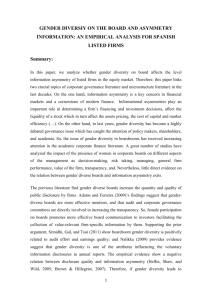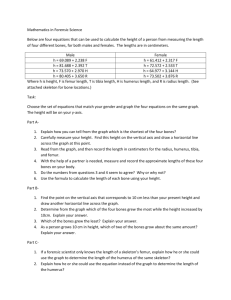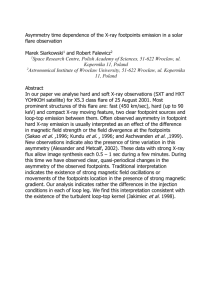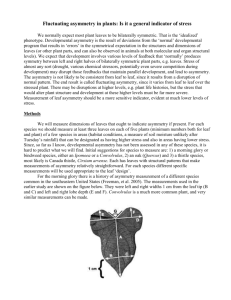LATERAL ASYMMETRY OF HUMAN LONG BONES
advertisement
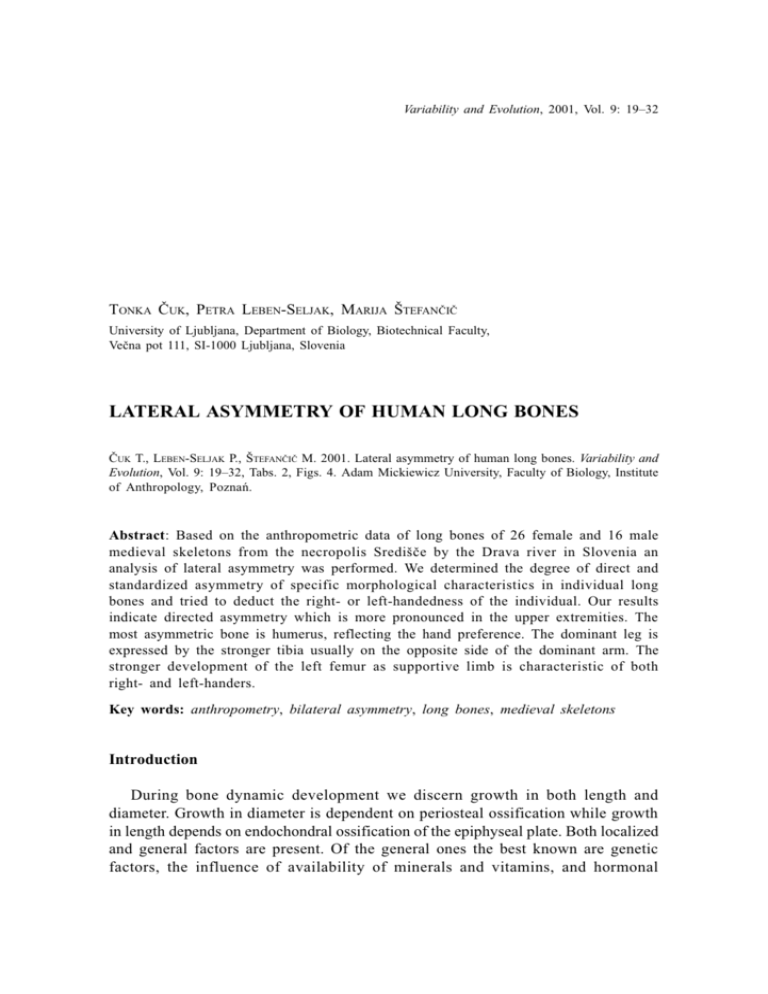
Lateral asymmetry of human long bones Variability and Evolution, 2001, Vol. 9: 1932 19 TONKA ÈUK, PETRA LEBEN-SELJAK, MARIJA TEFANÈIÈ University of Ljubljana, Department of Biology, Biotechnical Faculty, Veèna pot 111, SI-1000 Ljubljana, Slovenia LATERAL ASYMMETRY OF HUMAN LONG BONES ÈUK T., LEBEN-SELJAK P., TEFANÈIÈ M. 2001. Lateral asymmetry of human long bones. Variability and Evolution, Vol. 9: 1932, Tabs. 2, Figs. 4. Adam Mickiewicz University, Faculty of Biology, Institute of Anthropology, Poznañ. Abstract: Based on the anthropometric data of long bones of 26 female and 16 male medieval skeletons from the necropolis Sredièe by the Drava river in Slovenia an analysis of lateral asymmetry was performed. We determined the degree of direct and standardized asymmetry of specific morphological characteristics in individual long bones and tried to deduct the right- or left-handedness of the individual. Our results indicate directed asymmetry which is more pronounced in the upper extremities. The most asymmetric bone is humerus, reflecting the hand preference. The dominant leg is expressed by the stronger tibia usually on the opposite side of the dominant arm. The stronger development of the left femur as supportive limb is characteristic of both right- and left-handers. Key words: anthropometry, bilateral asymmetry, long bones, medieval skeletons Introduction During bone dynamic development we discern growth in both length and diameter. Growth in diameter is dependent on periosteal ossification while growth in length depends on endochondral ossification of the epiphyseal plate. Both localized and general factors are present. Of the general ones the best known are genetic factors, the influence of availability of minerals and vitamins, and hormonal 20 T. Èuk, P. Leben-Seljak, M. tefanèiè regulation. But localized factors, too, play a role: an adequate and uninterrupted blood flow and mechanical stresses on the bone (Ruszowski, Orliè 1977). In humans lateral asymmetry is wellknown. Current studies have confirmed the long held thesis that in the majority of people, in about 90%, the right arm is more developed than the left, while in the legs it is just the reverse, although less marked: 55% to 75% of people have a stronger left leg. This limb dominance only means an advantage in its use as shown by stronger musculature. The long bones are dependent on different degrees of stress and thus morphologically are bilaterally asymmetrical. The degree of asymmetry reflects the degree of force exerted onto the right or left limb, while the particular bone site showing asymmetry indicates the kind of force exerted. Studies of the degree of asymmetry in human long bones began on the nineteenth century. The most frequently used dimensions were the total length and weight measured both in skeletons and living people, and in archeological collections. Although data were gathered in different groups of people living in different circumstances all results agree and demonstrate that bilateral asymmetry is more marked in arm bones than leg bones and that on average right arm bones are longer by 1% to 3% and heavier by 2% to 4% than left limb bones. A few studies also mention that the bones of the left leg, particularly the femur, are on average longer and heavier than on the right but by less than 1%. The greater dimensions of the dominant arm were also confirmed by studies where they tested the link between increased activity and greater muscle mass or an increase in the mineral values of the bones. Thus, it seems that directional asymmetry of the long bones may be caused by local factors, particularly mechanical forces (Ruff, Jones 1981). Detailed statement about skeletal indicators of handedness was published recently (Steele 2000). Steel and Mays (1995) tried to answer the questions of asymmetrical long bone growth. Their measurements of the maximal length of the humerus, radius, and ulna in a series of 271 skeletons from the medieval osteologic collection in Wharram Percy in Yorkshire confirmed the presence of oriented asymmetry in arm bone length. The proportion of people with longer right or left long arm bones in this medieval population agreed with the proportion of right or left handers in modern populations. They determined that right- or left-handedness are the main causes of oriented asymmetry as they determine the use and thus the greater mechanical stress of the dominant arm. This could also be attributed to hidden genetic or hormonal factors, but the authors decry this thesis by the conclusion that asymmetry appears only when the limbs are asymmetrically mechanically loaded and increases with a childs age. Authors who have studied lateral asymmetry of the legs have confirmed that the left leg is heavier than the right but the results of differences in length are not uniform (Latimer, Lowrance 1965; Singh 1970). Ruff and Hayes studied the asymmetry in the shape of the femur. They determined that the left femur is stronger, Lateral asymmetry of human long bones 21 particularly in women but they did not find a difference in length (Ruff 1992). Macho (1991) was interested in how much bilateral asymmetry we can notice by measuring whole femurs. He chose those measurements most likely to be influenced by different forces. After statistical analysis on 166 South African Negroes thigh bones, he came to the conclusion that on average the left leg was stronger and in most people, regardless of right- or left-handedness, was the supporting leg while the right was used for other functions. In this study, performed by anthropometric methods in a long bone series of medieval skeletons from Sredièe by the Drava river, we tried to determine: 1. the degree of asymmetry of specific morphologic characteristics in individual long bones, 2. whether may we deduct the right- or left-handedness of the individual on the basis of this material. Materials and methods The sample The sample consists of 248 more or less preserved skeletons from the tenth to the fifteenth centuries exhumed in 1993 and 1994 in Sredièe by the Drava river, NE Slovenia. For the analysis we chose adult skeletons with preserved upper arm bones and at least one pair of another long bones. In all, we included 42 skeletons, 26 female and 16 male. Skeletal sex was determined by standard anthropological methods (Recommendations 1980). Methods To gain as much metric data as possible and to ensure that all parts of bones were represented, we chose those measurements according to Martin and Saller (1957) as well as 3 of our own. The maximum circumference of the humeral shaft (H-MCD) was measured with a measuring tape at the point of greatest circumference, approximately in the middle of the shaft or on the deltoid tuberosity. The bitubercular width of the humerus (H-BTW) was measured with a sliding caliper between the highest points of the major and minor tubercles. The sagittal diameter of the distal epiphysis of the ulna (U-SDD) was measured with a sliding caliper at the widest part of the epiphysis in the saggital plane. All measurements are given in centimeters with a precision of one millimeter as allowed by the instruments. The degree of direct asymmetry A for every measurement in individual skeletons was expressed as the difference between values in paired bones. Direct asymmetry is given in the same values as the measurements, that is in cm. It also told us how 22 T. Èuk, P. Leben-Seljak, M. tefanèiè many units one bone differed from the other and thus gave us the direction of asymmetry: A=DL (A, the degree of direct asymmetry; D, value of the right bone; L, value of the left bone). The degree of asymmetry was standardized by the mean values of measurements on the right and left sides. This standardized degree of asymmetry SA represented a ratio and thus had no units but made possible comparisons of any size regardless of the specific bone or the size of the skeleton. Just as direct asymmetry it also gave the direction of the asymmetry. SA = (D L) D+ L 2 ⋅ 1000 The statistical analysis was performed for individual data. The statistical results were checked by the two-way Students t-test. All analyses were done in Excel 7.0 for Windows 97. Because of the small number of paired bones, we did not separate them by sexes, following Steel and Mays (1995) who had found no differences in the degree of lateral asymmetry in the sexes, at least for lengths of the upper extremities. Results Tables 1 and 2 show the results of the analysis of metric data of the long bones and the standardized degree of asymmetry The results confirm the presence of oriented asymmetry more prominent in the arms than the legs. The average lateral asymmetry in the arms was to the right, in the legs to the left. By far the most asymmetric bone was the humerus where almost all the parameters were highly significant but particularly the minimal circumference of the shaft, the bitubercular width, and the maximal length. The total humeral length, the projection of the upper arm, only showed a smaller degree of asymmetry, yet it was still statistically significant. In the lower extremities only 2 parameters were significant: the length and the central circumference of the femur. These results are the average of a series where all preserved paired bones were studied. It is known that left-handers have a contrary direction of their asymmetry to right-handers in their arm bones, particularly the humerus, and this lowers average values. Because of this, we excluded probable left-handers and analysed them separately. Our criterion for exclusion was the direction of asymmetry in the most asymmetric bone, the humerus. This decision, of course, was somewhat hazardous as it was based only on the expression of anthropometric characteristics but the difference in the 2 groups was so large that it seemed reasonable. We add that the 23 Lateral asymmetry of human long bones percentage of left handers does reflect the actual numbers in the population, 15%, but in such a small series as ours was represented only by 5 subjects. We determined that the graphs of right-handers were very similar to the entire average population. In the arm bones the degree of right directed asymmetry was Table 1 The direction of lateral asymmetry of long bones Measure Direction of lateral asymmetry N* R>L [%] R=L [%] R<L [%] Humerus H-1 H-2 H-4 H-7 H-11 H-MCD H-BTW 30 26 33 42 37 35 22 26 21 10 29 13 19 13 87 81 30 69 35 54 59 1 1 18 11 23 13 8 3 4 55 26 62 37 36 3 4 5 2 1 3 1 10 15 15 5 3 9 5 Radius R-1 R-2 R-3 R-5.1 R-5.6 23 26 37 32 26 17 19 18 8 11 74 73 49 25 42 2 5 13 20 15 9 19 35 63 58 4 2 6 4 0 17 8 16 13 0 Ulna U-1 U-2 U-3 U-6 U-SDD 8 17 27 29 11 6 13 13 7 5 75 76 48 24 45 1 3 10 18 5 13 18 37 62 45 1 1 4 4 1 13 6 15 14 9 Femur F-1 F-2 F-8 F-9 F-10 F-18 F-19 F-21 32 32 33 33 33 35 33 28 9 8 7 7 5 9 7 6 28 25 21 21 15 26 21 21 4 3 8 13 20 17 16 18 13 9 24 39 61 49 48 64 19 21 18 13 8 9 10 4 59 66 55 39 24 26 30 14 Tibia T-1 T-1a T-3 T-6 T-8a T-9a T-10b 20 20 17 19 28 28 28 6 10 4 3 9 9 12 30 50 24 16 32 32 43 3 0 10 10 9 7 9 15 0 59 53 32 25 32 11 10 3 6 10 12 7 55 50 18 32 36 43 25 * Number of examined bone pairs 24 T. Èuk, P. Leben-Seljak, M. tefanèiè Table 2 The degree of lateral asymmetry of long bones Measure Direct asymmetry Standardised asymmetry A SDA t-test p SA SDSA t-test p Humerus H-1 H-2 H-4 H-7 H-11 H-MCD H-BTW 0.377 0.300 0.024 0.102 0.035 0.077 0.073 0.362 0.356 0.087 0.107 0.072 0.109 0.088 0.000 0.000 0.118 0.000 0.005 0.000 0.001 *** *** 12.120 9.909 4.113 18.663 15.316 11.089 17.202 11.391 11.407 14.570 18.981 29.645 15.688 20.692 0.000 0.000 0.115 0.000 0.003 0.000 0.001 *** *** Radius R-1 R-2 R-3 R-5.1 R-5.6 0.152 0.162 0.049 0.016 0.046 0.237 0.248 0.119 0.068 0.058 0.006 0.003 0.018 0.201 0.000 ** ** * 6.517 7.259 13.679 7.124 15.677 10.178 11.167 32.553 32.388 20.474 0.006 0.003 0.015 0.223 0.001 ** ** * Ulna U-1 U-2 U-3 U-6 U-SDD 0.250 0.206 0.033 0.007 0.045 0.302 0.301 0.073 0.070 0.082 0.052 0.012 0.026 0.602 0.096 10.430 9.647 10.350 4.454 22.818 12.171 14.294 22.361 32.226 40.714 0.046 0.013 0.024 0.463 0.093 * * * Femur F-1 F-2 F-8 F-9 F-10 F-18 F-19 F-21 0.166 0.169 0.061 0.012 0.015 0.000 0.012 0.011 0.472 0.403 0.150 0.099 0.076 0.084 0.078 0.069 0.056 0.024 0.027 0.488 0.258 1.000 0.379 0.415 3.900 3.970 7.357 3.603 5.783 0.450 3.391 1.696 10.598 9.043 18.125 32.930 31.612 18.057 17.268 9.345 0.046 0.019 0.026 0.534 0.301 0.884 0.268 0.345 * * * Tibia T-1 T-1a T-3 T6 T-8a T-9a T-10b 0.150 0.035 0.006 0.011 0.011 0.018 0.025 0.408 0.416 0.066 0.099 0.117 0.098 0.129 0.117 0.711 0.718 0.650 0.631 0.345 0.316 4.106 0.729 0.790 2.114 3.975 6.485 3.522 11.239 11.318 9.318 19.137 38.973 42.637 18.817 0.119 0.776 0.731 0.636 0.594 0.428 0.331 *** ** *** *** *** * * * * *** ** *** *** *** * p < 0.05; ** p < 0.01; *** p < 0.001 even higher than the average, the right handed dominance was even more expressed. The graph demonstrating the standardized lateral asymmetry of the left humerus is almost a mirror image of the right-handed graph, only the bitubercular width and the maximal shaft circumference were also greater on the right bone (Fig. 1). The 25 Lateral asymmetry of human long bones RIGHT-HANDERS 17,47 H-BTW 11,16 H-MCD 18,27 H-11 21,99 H-7 6,05 H-4 12,53 H-2 14,79 H-1 –20 –15 –10 –5 0 5 10 15 20 25 20 25 Degree of standardized asymmetry LEFT-HANDERS H-BTW 15,50 H-MCD 10,37 H-11 –9,08 H-7 –5,96 H-4 –6,71 H-2 –10,16 H-1 –11,93 –20 –15 –10 –5 0 5 10 15 Degree of standardized asymmetry Fig. 1. The average degree of standardized asymmetry of humerus 26 T. Èuk, P. Leben-Seljak, M. tefanèiè RIGHT-HANDERS 16,98 R-5,6 7,78 R-5,1 14,78 R-3 6,95 R-2 7,30 R-1 –-20 –15 –10 –5 0 5 10 15 20 25 15 20 25 Degree of standardized asymmetry LEFT-HANDERS 0,00 R-5,6 0,83 R-5,1 R-3 1,16 R-2 9,61 R-1 –1,69 –20 –15 –10 –5 0 5 10 Degree of standardized asymmetry Fig. 2. The average degree of standardized asymmetry of radius 27 Lateral asymmetry of human long bones RIGHT-HANDERS 2,03 F-21 –3,04 F-19 –0,44 F-18 –5,46 F-10 –5,19 F-9 –8,37 F-8 F-2 –3,42 F-1 –3,35 –20 –15 –10 –5 0 5 10 15 20 25 15 20 25 Degree of standardized asymmetry LEFT-HANDERS F-21 –0,29 F-19 –5,92 F-18 –0,55 F-10 –8,12 F-9 7,93 0,00 F-8 F-2 –7,82 F-1 –7,75 –20 –15 –10 –5 0 5 10 Degree of standardized asymmetry Fig. 3. The average degree of standardized asymmetry of femur 28 T. Èuk, P. Leben-Seljak, M. tefanèiè RIGHT-HANDERS 2,40 T-10b –4,86 T-9a –7,59 T-8a –5,06 T-6 0,05 T-3 –2,33 T-1a –6,35 T-1 –20 –15 –10 –5 0 5 10 15 20 25 Degree of standardized asymmetry LEFT-HANDERS T-10b 10,23 T-9a –16,21 T-8a 17,70 T-6 8,93 T-3 6,37 T-1a 5,69 T-1 4,88 –20 –15 –10 –5 0 5 10 15 Degree of standardized asymmetry Fig. 4. The average degree of standardized asymmetry of tibia 20 25 Lateral asymmetry of human long bones 29 left-handed radius showed a much lesser degree of asymmetry but, except for maximal lengths, was expressed as favouring the right (Fig. 2). Both right- and left-handers had a stronger left femur, only the transverse diameter of the diaphysis was greater on the right in left-handers (Fig. 3). Right-handers had a longer and stronger left tibia while left-handers were stronger on the right with the exception of the shaft transverse diameter (Fig. 4). Discussion Our results confirm the findings of other authors that lateral asymmetry is directional asymmetry, that in the arm bones particularly the humerus was much more prominently expressed that in the lower limbs. In all long bones the minimal circumference and shaft width were more asymmetric than the maximal bone length. Steele and Mays (1995) found that asymmetry in humeral length was markedly smaller than the lateral differences in the strength of compression that in the modern population is 68%. They cite that other authors had proved that there is a greater degree of asymmetry in the shaft circumference coinsiding with differences in the strength of arm compression. In our sample the degree of lateral asymmetry in diameters was smaller than the differences in hand compression (the difference in the humeral minimal circumference was 2.1%) but was greater than the degree of asymmetry in the length of the bone. The length difference between the right and left was 1.4%, equal to that found by Steele and Mays (1995). We think that this is a consequence of length growth stopping between 18 and 25 years of age while width increases under biomechanical factors during the life span. Steele and Mays also see another explanation; the consequence of a compromise between the effect of asymmetry of strength in potentiated use of the dominant hand and the effect of antagonistic muscles forces with coordination of both hands. We found that the proximal epiphysis of humerus was more asymmetric than the distal one. The reverse held true for the forearm bones where the asymmetry was greatest distally. It is apparent that the wrist and shoulder have greater asymmetric stresses than the elbow. The leg bones showed a reverse direction of asymmetry from the arm bones and the degree of asymmetry was lesser. The sagittal diameter of the femur was more asymmetric towards the left, meaning a greater vertical flattening of the head and thus a greater stress on the bone. The left femur was obviously stronger, all measurements of the diaphysis were larger and longer. These increased dimensions on the left argue that it is the supporting side. The exception is the greater epicondilar width on the right femur, a fact that Macho (1991) explains as a consequence of the greater shearing forces in the knee as compared to the nondominant leg. In the tibia the greatest average degree of asymmetry is shown by the transverse and 30 T. Èuk, P. Leben-Seljak, M. tefanèiè sagittal diameter of the diaphysis. This did not surprise us: most of the muscle insertions are here. But as standard deviations in all measurements are high, the lateral differences could not be proven statistically. It is interesting that results of analysis of Old Slav long bones from Slovakia gave a similar result even though Avenariova (1971) did not demonstrate asymmetry in any other studied bone. This is probably due to the fact that average asymmetry for all sizes was considered to be the difference between the averages of left and right bones, which is not a reflection of the actual differences in individual samples. The separation of right-handers from left-handers confirmed our expectations in the arm bones. The degree of right handed asymmetry of the humerus and radius in right-handers was even more potentiated. Left-handers had a longer and distally stronger humerus. It is interesting that bitubercular width and the maximal circumference were stronger in left-handers on the right humerus. Both these sites are at the proximal end of the humeral diaphysis where the abductors insert (the deltoid, supraspinatus, infraspinatus muscles) and the inner rotator (subscapular muscle) of the shoulder. Obviously these left-handers did physical work with their right arms. Our results also showed differences in the degree of asymmetry in bones of the lower extremities which were particularly interesting as we have not found similar data in the literature. In general it is believed that people develop transverse asymmetry, meaning that right-handers have better developed right arms and left legs with the reverse in left-handers (Ruff, Jones 1981). One also finds the thesis that the left leg is supportive without regard to right- or left-handedness while the right has other functions, for example kicking (Singh 1970; Plato et al. 1985; Macho 1991). In the majority of our skeletons, without regard to right- or left-handedness, the femurs were stronger on the left as the average asymmetry is the same for both groups. But in direct contrast the asymmetry in tibias was completely reversed. The length as well as the circumference and width were larger in left-handers, only the transverse shaft diameter showed a negative asymmetry. Thus the tibia, at least in our material, demonstrated transverse asymmetry with the humerus. This means that right-handers have a dominant left leg, left-handers a dominant right leg. On the other hand, from the asymmetry of the femur we could deduce that regardless of right or left handedness the supportive leg is usually on the left. A dominant leg therefore does not always mean a supportive leg. While studying the laterality of student legs, kof (1991) actually decided the dominant leg was the one used to push off during a start and as supportive the one used to support oneself when thrown off balance. She found that it was not always the same extremity. In most students the left leg was supportive without regard to right or left handedness. She found no connection between the supportive and the dominant leg as the degree of asymmetry was insignificant. In view of these facts, we offer the thesis that the dominant leg lying opposite to the dominant arm is expressed as a more developed tibia. In the majority of people the supportive leg, without regard to hand dominance, is the left as shown by the Lateral asymmetry of human long bones 31 greater development of the femurs in both right and left-handers. The dominance of the lower extremity is less marked than that of the upper. But, of course, this must be checked on a sample where we know both the dominant and the supportive extremity. Conclusions Our sample population consisted of 248 skeletons from the burial ground at Sredièe by the Drava river representing the Slav population between the tenth and fifteenth centuries. To analyze lateral asymmetry we could only use those skeletons whose sex could be determined and which had both humeri and at least another pair of long bones.There were 42 skeletons, 26 female and 16 male. Based on our analysis of them, we determined the lateral asymmetry and tried to determine its cause. Our conclusions can be summed up as: 1. Asymmetry is directed and more pronounced in the upper extremities than the lower. This can be partly explained by the fact that we use our arms in countless one-handed and both-handed ways. To a great degree the legs are intended for walking, bipedal locomotion demanding the equal use of both extremities. 2. The most bilaterally asymmetric is the humerus, reflecting the hand preference. We think that in skeletons with both preserved humeri we can determine right- or left-handedness. The analysis has shown a major difference in asymmetry of those skeletons with a better developed right humerus than the left and the latter represent only 12% of our sample, a figure compatible with the presence of left-handers in the population. 3. The dominant leg was expressed by the stronger tibia usually on the opposite side of the dominant arm. Thus, right-handers usually have a dominant left leg, left-handers a dominant right. Regardless of the hand preference and the dominant leg, the left is the supportive limb as proven by the greater development of the left leg in both right- and left-handers. We have tried to elucidate asymmetry from several standpoints. All of these results are valid for our sample population but, because of the small available archeological sample, generalization is dangerous yet leaves the door open for further study. References Avenariova I. 1971. Analyse der Extremitatenknochen aus slawischen Graberfeld auf der Bratislaver Burg. Acta Facultatis Rerum Naturalium Universitatis Comenianae Anthropologia, 18: 7997. Latimer H.B., Lowrance E.W. 1965. Bilateral asymmetry in weight and in length of human bones. The Anatomical Record, 152: 217224. Macho G.A.,1991. Anthropological evaluation of left-right differences in the femur of southern African populations. Anthropologischer Anzeiger, 49: 207216. Martin R., Saller K. 1957. Lehrbuch der Anthropologie I. Gustav Fischer Verlag, Stuttgart. 32 T. Èuk, P. Leben-Seljak, M. tefanèiè Plato C.C., Fox K.M., Garruto R. M. 1985. Measures of lateral functional dominance: foot preference, eye preference, digital interlocking, arm folding and foot overlapping. Human Biology, 57: 327334. Recommendations 1980. Recommendations for age and sex determination. Journal of Human Evolution, 9: 517548. Ruff C. 1992. Biomechanical analyses of archaeological human skeletal samples. In: S.R. Sounders, M.A. Katzenberg (eds.), Skeletal Biology of Past Peoples: Research Methods. Wiley-Liss, New York, 3758. Ruff C.B., Jones H.H. 1981. Bilateral asymmetry in cortical bone of the humerus and tibia sex and age factors. Human Biology, 53: 6986. Ruszowski I., Orliæ D. 1977. Utjecaj mehanièkih faktora na uzduni rast kosti. Glasnik Antropolokog Drutva Jugoslavije, 14: 127135. Singh I. 1970. Functional asymmetry in the lower limbs. Acta Anatomica, 77: 131138. Steele J. 2000. Skeletal indicators of handedness. In: M. Cox, S. Mays (eds.), Human Osteology. In: Archaeology and Forensic Science. Greenwich Medical Media, London, 307323. Steele J., Mays S. 1995. Handedness and directional asymmetry in the long bones of the human upper limb. International Journal of Osteoarchaeology, 5: 3949. kof U. 1991. Funkcionalna in morfoloka lateralnost spodnjih ekstremitet pri ljubljanskih srednjeolcih. Diplomska naloga, Univerza v Ljubljani, Biotehnika fakulteta, Oddelek za biologijo.

